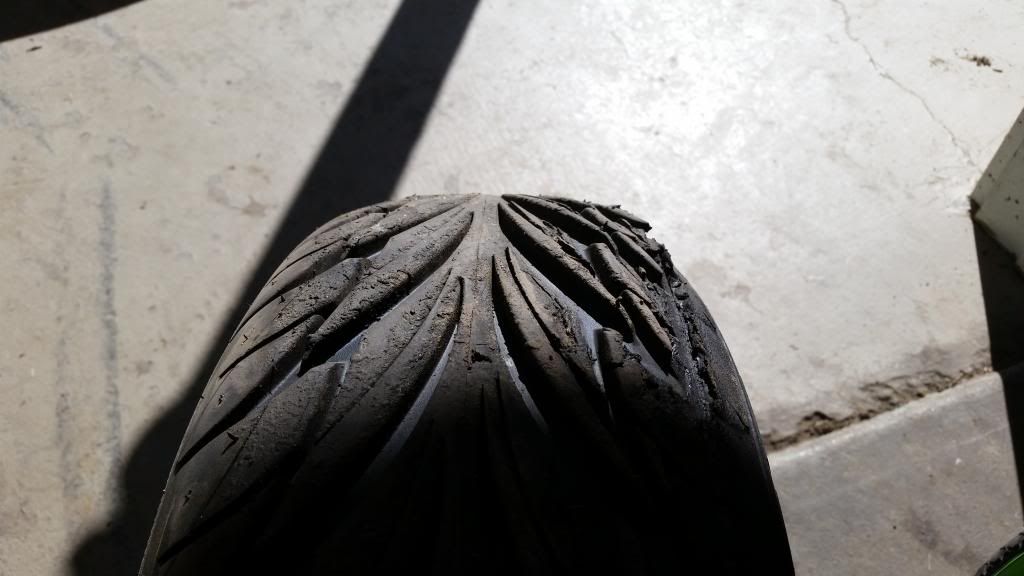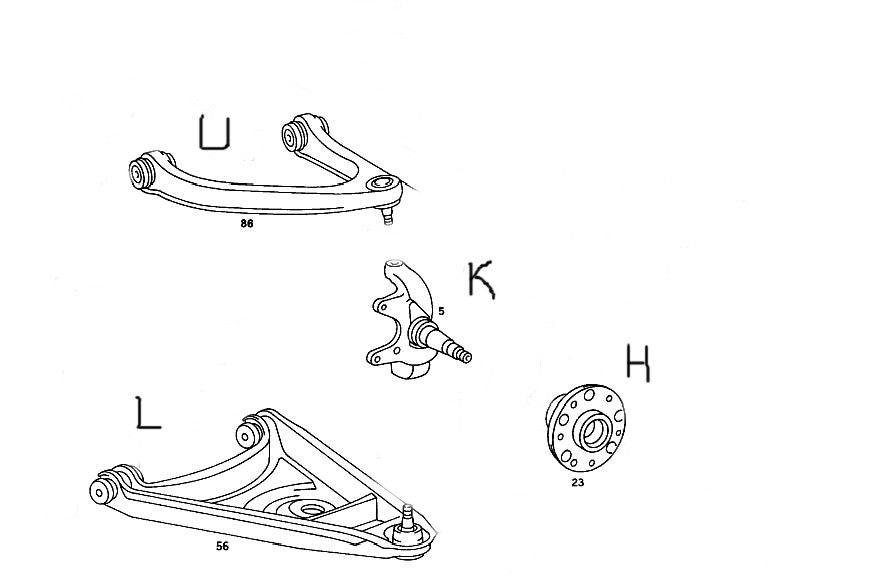Stump the Group - Weird Math
| June 7th, 2014 at 6:28:45 AM permalink | |
| Face Member since: Oct 24, 2012 Threads: 61 Posts: 3941 | I'm so bad at math I can't even tell whether this will be something someone can figure out in 30 seconds or whether it will take engineer-level brain melting mathematics to solve. If it's the latter, don't bother. I'll just do what I always do and wing it ;) My question today is about camber. So we all know what I'm asking, camber is the measurement of wheel tilt on a car. Here's a very absurd example so you can picture it.  The above is stupid, but it illustrates what I'm trying to do. I need to dial a little bit of camber into my race car because the straight up and down posture of my tires is murdering them. I'm using up a tire every week. Diving into those banked corners with a straight tire is causing me to use only the shoulder, maybe 1/3rd of the entire tire. This is what I get as a result...  There are two proper ways to get camber. One is to buy suspension kits that create it. I can neither afford them, nor are they legal. Everything needs to remain stock, so that's out. The other is to go to a collision shop that has a unibody frame restorer and use it to twist the whole front end of the car so it's crooked. I can't afford that either =p But I had an idea. This is a (very) crude drawing of the main suspension components of my car.  The black is the tire, the blue represents the knuckle, and the red represents the control arms. I figure all I need to do is shorten that upper control arm, the one the arrow is pointing to, and that will pull the top of the tire inwards and give me the camber I desire. Good idea, right? =) Well, the degree of camber is limited by the rules. I can't just whack a chunk out and run it or I risk disqualification. What I need to know, and the reason for this post, is the math. How do I translate the mm or cm I shorten that control arm into degrees of tilt in the wheel? While it's not rocket surgery, the disassembling, cutting, grinding, heating, bending, welding and reassembling of all that isn't a quick job. It's not something I want to do over and over until I get it right. I'd like to be able to measure it and just do it once, if possible. So... is this easy math? Or should I have stayed in school? =p (Seriously, if this will take you more than 5 minutes to suss out, I'll just wing it. I just thought I'd take a chance is was something easy and I was being handcuffed by my math ignorance) Be bold and risk defeat, or be cautious and encourage it. |
| June 7th, 2014 at 8:07:21 PM permalink | |
| Wizard Administrator Member since: Oct 23, 2012 Threads: 239 Posts: 6095 | Can I trouble you to give a specific case as an example? I'm having a hard time understanding what is being asked. Here is a side question for Paco: Comfirm or deny a common etymology with cambiar (to change). Knowledge is Good -- Emil Faber |
| June 8th, 2014 at 2:14:00 AM permalink | |
| Pacomartin Member since: Oct 24, 2012 Threads: 1068 Posts: 12569 |
It is actually related to "camera" through a somewhat complex etymology.  Camber gage  |
| June 8th, 2014 at 12:57:02 PM permalink | |
| Face Member since: Oct 24, 2012 Threads: 61 Posts: 3941 |
Trouble me? Ha! It's no trouble at all. But if you ask for clarification, I go all in ;) Camber, as Paco's pictures illustrate, is the measure in degrees of how much the wheel tilts from true. Street cars typically have 0* camber. With no camber, the wheel is oriented straight up and down. This is perfect for flat surface streets as it keeps the entire width of the tire in contact with the road. On a race track, the corners are steeply banked. If you have 0* camber and your tire is straight up and down, the banking causes only the very outside edge of the tire to contact the road. Here's another crude illustration to help you envision it.  The tire has 0* camber and is straight up and down. The red line represents a flat city street. As you can see, the whole tire contacts it. The blue line represents the road surface of a steeply banked corner on a track. As you can see, only a scant edge of the tire contacts it. Using only that tiny bit of the tire not only affects performance, but destroys the outside edge of the tire as shown in this pic.  The left side (inside) and middle of the tire aren't even touched, while the right side (outside) is shredded down to the steel belts. This tire has 12 (TWELVE!) miles on it. That's how serious my lack of camber is affecting things. Now for the parts...  This is a simplified vision of what makes up the corner of a car. The part marked "H" is the hub. This is the piece that holds the lug nuts which allows you to attach the wheel, and it houses the bearings which allow the wheel to spin. "K" is the steering knuckle. The hub and wheel assembly are held by the knuckle. The knuckle is what allows the wheel to turn left and right. "U" and "L" are the upper and lower control arms. This is what attaches the knuckle/hub/wheel assembly to the car. In the pic above, the single ball joint on the right end of the control arms attaches to the knuckle, while the two bushing ends on the left side connect to the car. Now imagine this all assembled. The wheel goes on the hub, the hub goes on the knuckle, the knuckle goes on the control arms, and the control arms go onto the car. In order to get the camber I desire, I need to shorten the upper control arm by cutting a chunk out of it and welding it back together. By making the upper arm shorter, it will pull the top of the knuckle in, which will pull the top of the hub in, which will pull the top of the wheel in. If the top comes in but the bottom stays out, boom. I have camber.  My question is how do I translate the length I cut out of "U" into degrees of tilt in "K"? Be bold and risk defeat, or be cautious and encourage it. |
| June 8th, 2014 at 2:21:57 PM permalink | |
| Fleastiff Member since: Oct 27, 2012 Threads: 62 Posts: 7831 | It's called Dynamic Curve and it's part of the Active Body control suspension system on the new 2015 Mercedes-Benz S-Class Coupe. In turns, special plunger cylinders raise the suspension struts and lower the opposite side, depending on the direction of the bend. This has the result of tilting the car body slightly towards the inside of the corner, countering centrifugal cornering forces. Mercedes says it's not design for increasing cornering speeds, but increasing pleasure for the driver and passengers." |
| June 8th, 2014 at 4:13:00 PM permalink | |||||||||||||||||||||||||||||||||||||||||||||||||||||||||||||||||
| Pacomartin Member since: Oct 24, 2012 Threads: 1068 Posts: 12569 |
Use the table below. For instance if K is 10 inches and you want an 8 degree camber, then the length you cut from U is calculated by 13.92%*10"= 1.39".
| ||||||||||||||||||||||||||||||||||||||||||||||||||||||||||||||||
| June 8th, 2014 at 4:56:08 PM permalink | |
| Face Member since: Oct 24, 2012 Threads: 61 Posts: 3941 | And that formula can be used no matter the value of "K"? So whatever degree I want, I use the "Times K" value of that degree, multiply that by "K", and I get the inches I need to lop off of "U"? Be bold and risk defeat, or be cautious and encourage it. |
| June 8th, 2014 at 8:24:51 PM permalink | |
| Pacomartin Member since: Oct 24, 2012 Threads: 1068 Posts: 12569 |
Yes. |
| June 8th, 2014 at 8:56:21 PM permalink | |
| Face Member since: Oct 24, 2012 Threads: 61 Posts: 3941 |
Aww, man. This was like 10th grade math, wasn't it? -_- Be bold and risk defeat, or be cautious and encourage it. |
| June 9th, 2014 at 1:13:25 AM permalink | |
| Pacomartin Member since: Oct 24, 2012 Threads: 1068 Posts: 12569 |
It is in the high school curriculum, but I think it is taught in 11th grade normally. But you are hardly the first person to forget their high school math. I had an educated woman ask me about dividing by fractions (for instance 6 divided by 1/3 is 18). She said she never understood how you could divide by something and end up with a bigger number than you began with. She said division was inherently dividing something into smaller pieces, like dividing a pizza. I could hardly point out that should have been covered in elementary school. But somehow she never understood the concept. Incidentally, I just printed out the sine function for 1 to 30 degrees. |

